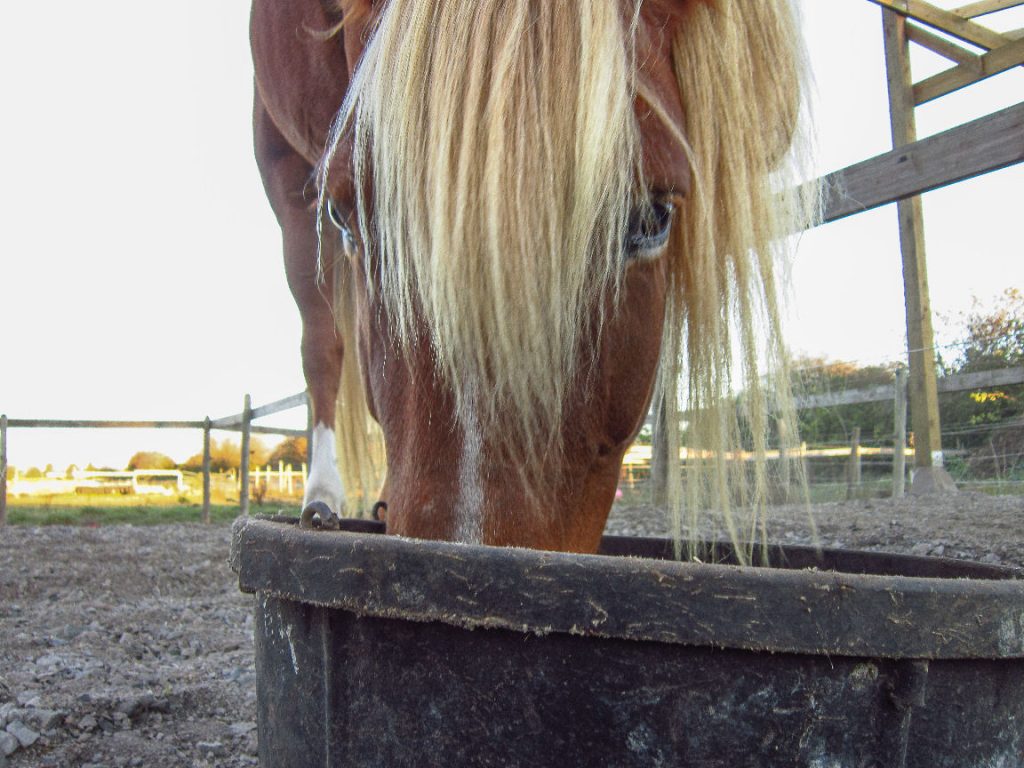Horsemanship Level 4: Feeding (pt II)
Last week we looked at the nine rules of good feeding as part of your Feeding topic for Level 4. This week we'll cover:
Common grains, concentrates & processing methods. Own routine & ration.
In an ideal situation a horse is able to get all the food it needs from forage. When grazing is unavailable or insufficient, hay (dried grass) forms the staple of a horse's diet. However, as a dried food, hay is sometimes too low in calories or nutrients for all horses, and grain or processed feed is needed. Grain can be feed whole or crushed, or processed into pelleted feeds. Most cubes or pellets have additional vitamins added and are often a better choice than grain if the forage is lacking in some nutriets. There is a multitude of concentrates available in the feed store these days. Here are a few of the most common.
Oats
Oats are the most common grain fed to horses and can be used whole, crushed, or flatted (rolled). Whole oats can be stored longer without losing nutrional value, but are less digestible than processed grain. Oats are high in carbohydrates and can make some horses too 'hot' or excitable, as well as posing a laminitis risk.
COB (Corn, Oats, Barley)
This mix of flatted corn, oats, and barley provides a more balanced ration. Barley is easier to digest and less sugary than oats, while corn is fattening and quite sweet. Together the mixture has a similar carbohydrate load to straight oats, but has a wider nutrient range. Some COB mixes have molasses added, and should be fed cautiously.
Beet Pulp
The by-product of sugar production, beet pulp is high in fibre and calcium and most horses like it. The pellets are very hard and dry, and should be soaked for about eight hours prior to feeding to avoid choke. Some beet pulp has added molasses, which increases the nutrients but also the carbohydrates.
Complete Feed
Although the name implies the horse needs no other food, in fact most complete feeds do not have a forage component, and so hay must still make up the bulk of the horse's ration. Complete feeds can be pelleted or extruded, and usually contain a balance of vitamins, minerals, fats, protein and carbohydrates. Check the label to see the percentages of protein and fat, as well as vitamin and mineral content. Feeds labelled 'High Fat' may go bad more quickly and often contain more sugar to make them palatable. Adding vegetable oil to a low-fat feed can serve the same purpose at a lower cost.
Bran
Often fed as a warm mash, bran can be useful to nurse a sick horse who is off his food or not drinking enough water. However, too much bran can cause a horse to lose calcium and magnesium, so should be fed as an occasional treat rather than a daily feed.
Flax
When mixed with water and cooked or left to steep, flax forms a jelly that can be used the same way as bran mash as a treat or to entice a sick horse to eat. High in omega-3 oil, flax improves the coat and is a good source of fat. If fed as a grain it should be ground and then used soon as it goes bad quickly.
Own Routine and Ration
For your test, be sure to know what your horse (or the horse you are using) is fed and why. If your horse is a good keeper, he likely is on hay with a small amount of complete feed for vitamins. A hotter horse or one prone to laminitis may have oil to increase calories without starch. Older horses may have special vitamin supplements or 'senior feed' formulated for their needs, and may receive their hay as chopped chaff or soaked hay cubes to help digestibility. You should be able to give the general properties of each feed your horse is on, and the benefits and drawbacks of each.
Current and Upcoming Classes
Assessments are coming up on March 13th! Check in with your instructor to make sure you’re ready. If you aren’t currently in classes and would like to do either a Horsemanship, Riding or Mounted Combat assessment be sure to register well in advance. All classes take place at Red Colt Co-op, 12320 No 2 Road, in Richmond.
Mounted Combat Assessments
Sunday 6 March, 1:00 – 4:30pm
cost: $50 for one assessment; $80 for two or more
one assessment included with each 5 or 6 week course
Intermediate Mounted Combat
Sundays 7 Feb – 6 Mar, 1pm – 3pm
Sundays 13 Mar – 10 Apr, 1pm – 3pm
cost: $160 + gst
Mounted Combat Fundamentals
Sundays 7 February – 6 Mar, 1:30 – 3pm
Sundays 13 Mar – 10 Apr, 1:30 – 3pm
cost: $120 + gst
Beginner Riding & Horsemanship
Sundays 31 Jan – 6 Mar, 10am – noon – FULL
Sundays 13 Mar – 17 Apr, 10am – noon
cost: $300 + gst
Riding & Horsemanship Level 2
Sundays 13 Mar – 17 Apr, 10am – noon
cost: $300 + gst
Horsemanship Level 3-4
Sundays 13 Mar – 17 Apr, 10:30 – 11:30am
cost: $130 + gst
Riding Level 3+
Sundays 13 Mar – 17 Apr, noon – 1pm
cost: $200 + gst
Mounted Combat Playday
Sunday 3 April, 1:00 – 4:00pm
cost: $15 + $15 for use of school horse
Free for ground crew & spectators!
